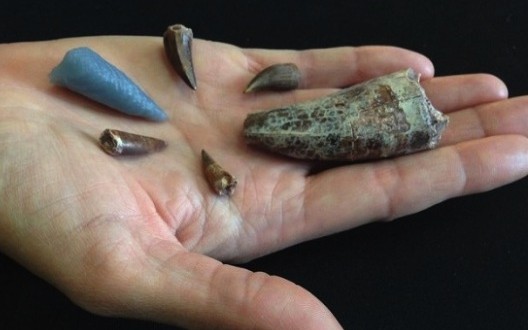The evidence comes from a team of U.S. scientists who found remnants of a prehistoric clash in a slab of rock at the Chinle Formation in New Mexico. The battle, which occurred in the Triassic period about 210 million years ago, involved a semi-aquatic crocodile-like dinosaur called phytosaur and a large reptile called rauisuchid, and ended with the tooth of the former embedded in the bone of the latter.
In a paper published online in September in the German journal Naturwissenschaften, Stephanie Drumheller of the University of Tennessee and Michelle Stocker and Sterling Nesbitt, vertebrate paleontologists with the Virginia Tech’s Department of Geosciences, present evidence the two creatures not only interacted, but did so on purpose.
“Phytosaurs were thought to be dominant aquatic predators because of their large size and similarity to modern crocodylians,” said Stocker, “but we were able to provide the first direct evidence they targeted both aquatic and large terrestrial prey.”
The evidence? A tooth. Not just any tooth, but the tooth of a phytosaur lodged in the thigh bone of a rauisuchid, a creature about 25 feet long and 4 feet high at the hip. The tooth lay broken off and buried about two inches deep in bone, and then healed over, indicating the rauisuchid survived the attack.
“Finding teeth embedded directly in fossil bone is very, very rare,” Drumheller said. “This is the first time it’s been identified among phytosaurs, and it gives us a smoking gun for interpreting this set of bite marks.”
The researchers came across the bone by chance at the University of California Museum of Paleontology in Berkeley.
“It was remarkable we were able to reconstruct a part of an ancient food web from over 210 million years ago from a few shallow marks and a tooth in a bone,” said Nesbitt. “It goes to show how careful observation can lead to important discoveries even when you’re not seeking those answers.
“We came across this bone and realized pretty quickly we had something special,” Nesbitt said. “There are many bones that get dug up, not all are immediately processed, prepared, and studied. No one had recognized the importance of this specimen before but we were able to borrow it and make our study.”
The large rauisuchid thigh bone at the center of the research has the tooth of the attacker, which the researchers recreated using CT scans and a 3-D printer. Multiple bite marks indicate the creature was preyed upon at least twice over the course of its life, by phytosaurs.
“This research will call for us to go back and look at some of the assumptions we’ve had in regard to the Late Triassic ecosystems,” Stocker said. “The distinctions between aquatic and terrestrial distinctions were over-simplified and I think we’ve made a case that the two spheres were intimately connected.”
Agencies/Canadajournal
 Canada Journal – News of the World Articles and videos to bring you the biggest Canadian news stories from across the country every day
Canada Journal – News of the World Articles and videos to bring you the biggest Canadian news stories from across the country every day



